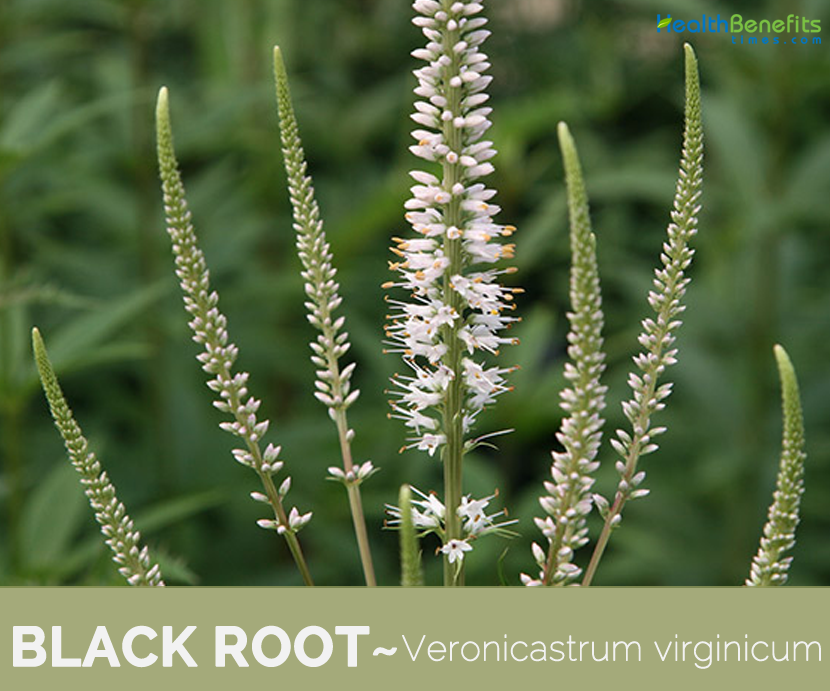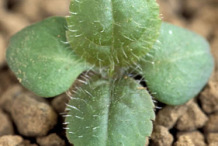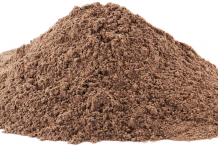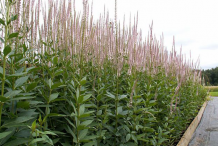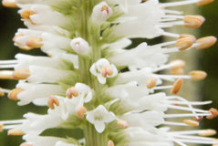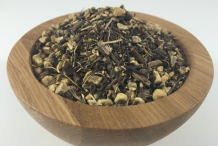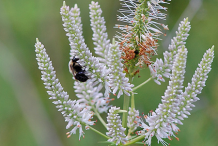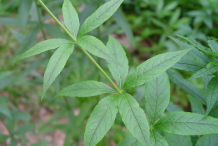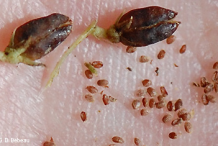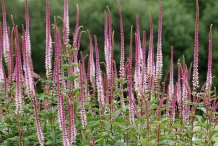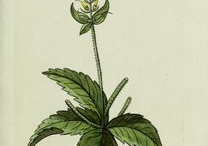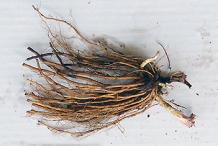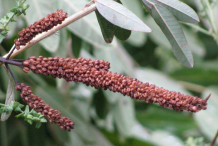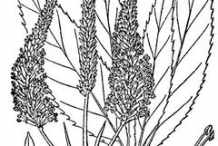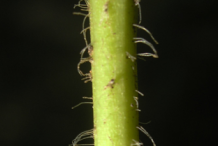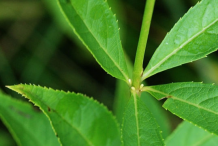Plant Description
Black Root is an erect perennial herb that grows about 5-6 ft. tall (120-150 cm) and 2 ft. wide (60 cm). The plant is found growing in moist tall grass prairie and prairie remnants, moist woods, woodland borders, thickets, fields and meadows, stream banks, terraces, roadsides, road allowances, and railway right-of-ways. Growth is best in rich loamy soil, although some sand or clay is also tolerated. The rhizome is horizontal, cylindrical, branched and dark red to dark purple-brown on the outside. The simple, erect stems grow in intervals of 1.2 to 3.2 cm from the rhizome. They are smooth and finely downy.
Leaves
Leaves are in whorls of 3 to 7 with the whorls widely spaced on the stem. They are dark green, oblong to ovate with fine teeth on the margins and taper to a short stalk. The veins are prominent with a mid-rib and curving lateral veins; the top side is usually hairless, the underside is much paler in color and can have fine hair especially on the ribs.
Flower
The inflorescence is a dense spike atop the stem. All but the most immature plants will have several smaller flower spikes rising from the stem below the central spike, which is the first to develop. Flowers are small, 4-parted, about 1/4 to 1/3 inch long, tubular shaped with a white corolla whose lips spread slightly. The lips are much shorter than the corolla tube, with the upper lip having one lobe and the lower lip with 3 lobes. From the tube protrude two stamens that have white filaments and deep yellow to brown anthers. Also protruding is a single white style. The calyx is green, short with pointed lobes (sepals). The flowers bloom from the bottom of the spike up. Several spikes surround the main spike at the top of the plant. Flowering normally takes place from Jul to August
Fruit & Seed
Florets mature into oblong-ovate, flattened, many seeded capsules. Fertile flowers produce a seed capsule that is longer than the calyx. The small, dry, brown, ellipsoid shaped seeds are not easily detached from the capsule as it does not split open very far at the top, and thus end up on the ground still inside the capsule. Seeds can germinate without a waiting period in warm and moist conditions. They are very small and need light for germination. If stored, storage should be in cold dry conditions.
History
The first documented use of Culver’s root was when Puritan leader Cotton Mather requested it as a remedy for his daughter’s tuberculosis in 1716. Culver’s root was used by early physicians as a powerful laxative and emetic. Native American tribes also used the plant and drank tea preparations to induce vomiting and to help cleanse the blood. Herbalists have used Culver’s root for its ability to increase the flow of bile from the liver. Today it is found used throughout the world due to its health promoting benefits.
Traditional uses and benefits of Black Root (Culver’s root)
- Culver’s root has been used medicinally for liver disorders and constipation.
- It is occasionally considered when compounding a formula for the liver, gallbladder, to treat constipation, colitis, gallstones and hepatitis.
- Beaumont’s root was used medicinally by several native North American Indian tribes who used it to treat a variety of complaints
- It is still occasionally used in modern herbalism, mainly for its effect upon the liver and bile production.
- Root is anodyne, cathartic, emetic, hepatic, laxative and tonic.
- Fresh root is a violent cathartic and possibly emetic, the dried root is milder in its action, but less certain.
- Root also gently excites the liver and increases the flow of bile.
- An infusion has been used in the treatment of diarrhea, coughs, chills and fevers, and also to ease the pain of backaches.
- Tea made from the roots is strongly laxative.
- It is also used to treat headache, back pain, anorexia, depression, chills and flatulence.
- Native American tribe, Chippewa, used the root in the form of a blood sanitizer.
- Herbalists used the dehydrated black root to treat liver ailments as well as to cure persistent indigestion and other medical conditions that were believed to occur owing to the dysfunction of the liver.
- Black root is given to cure skin problems in case the functioning of the patient’s liver is poor.
- Black root also serves as a tonic for the stomach and is effective in treating diarrhea, persistent dysentery, torpidity of the liver and cholera infantum.
- Decoction prepared with the dried root of black root may perhaps be effective in treating sporadic fevers.
- Dehydrated root of the herb has been successfully used in treating leprosy as well as cachetic diseases as well as in conjugation with cream of tartar in treating dropsy.
- Black root is known to be a useful natural remedy for malaise or anxiety, pain when pressure is applied and chubbiness around the liver.
- It is also recommended to treat loss of appetite, lethargic functioning of the liver, indolence of the gastrointestinal organs, cold skin and extremities, dull headaches, intense stupor and mental depression.
- Black root helps to strengthen these organs and enhances their functioning.
- It also fortifies the gastrointestinal tract, improves the actions of the glandular organs and, hence, is recommended for curing all types of indolence or torpidity of the organs.
- The Seneca Indians used the plant in tea form to induce vomiting as a part of purification rituals.
- It was also used to treat malaria and typhoid fever.
Usual dosage
Herbal formulations prepared with black root are taken in forms of decoction as well as tincture.
- Decoction: To prepare the decoction add one to two teaspoonful of the dehydrated herb to a cup (250 ml) of cold water and boil the mixture. Subsequently, allow the mixture to simmer for about 10 minutes and filter the liquid. For best results, drink one cup of the decoction thrice every day.
- Tincture: The tincture prepared with black root should be taken in dosage of 2 ml to 4 ml thrice every day.
Other Facts
- Culver’s root is cultivated as a garden flower in the Eastern United States.
- Native Americans also used it for spiritual purposes.
Precautions
- This herb should never be given during pregnancy, as it may harm the fetus or result in forced abortion.
- Black root should also be avoided by nursing mothers, as its elements may pass onto the breast milk and prove to be detrimental for the health of the new born.
- Black root should not be used by people enduring problems of the gall bladder or having gall stones.
- People having inflammation of the stomach or intestines, for instance Crohn’s disease or colitis, should also avoid using black root.
- Women should not take this herb during their menstrual period.
- High doses of the herb can cause nausea, vomiting, and diarrhea.
- As the herb has powerful laxative (purgative) properties it can cause dizziness and bloody stools.
- Do not use black root if you have hemorrhoids. It can act as a laxative and make hemorrhoids more annoying.
References:
https://www.itis.gov/servlet/SingleRpt/SingleRpt?search_topic=TSN&search_value=34073#null
https://davesgarden.com/guides/pf/go/85/
https://npgsweb.ars-grin.gov/gringlobal/taxonomydetail.aspx?id=400612
https://www.pfaf.org/USER/Plant.aspx?LatinName=Veronicastrum+virginicum
http://www.missouribotanicalgarden.org/PlantFinder/PlantFinderDetails.aspx?kempercode=g180
http://www.theplantlist.org/tpl1.1/record/kew-2461992
https://plants.usda.gov/core/profile?symbol=vevi4
https://en.wikipedia.org/wiki/Veronicastrum_virginicum
Comments
| Black Root (Culver's Root) Quick Facts | |
|---|---|
| Name: | Black Root (Culver's Root) |
| Scientific Name: | Veronicastrum virginicum |
| Origin | United States |
| Shapes | Oblong-ovate, flattened, many seeded capsules |
| Taste | Bitter and nauseating taste |
| Health benefits | Good for constipation, colitis, gallstones, hepatitis, treats diarrhea, coughs, chills and fevers |
| Name | Black Root |
|---|---|
| Scientific Name | Veronicastrum virginicum |
| Native | United States |
| Common Names | Culver’s-root, Culverpsyic, Culver’s physic, Bowman’s root, black root, tall-speedwell, Beaumont’s Root, Brinton Root, Hini, Leptandra, Oxadoddy, Purple Leptandra, Tall Veronica, Whorlywort |
| Name in Other Languages | English: Culver’s root, Blackroot, Bowman’s-root, Tall-speedwell, Virginia Culver’s root, Bowman’s root, Tall speedwell, Beaumont’s Root, Culverpsyic French: Véronique de Virgine, Véronicastre de Virginie German: Ehrenpreis Icelandic: Skessudepla Swedish: Kransveronika |
| Plant Growth Habit | Erect perennial herb |
| Growing Climate | Moist tall grass prairie and prairie remnants, moist woods, woodland borders, thickets, fields and meadows, stream banks, terraces, roadsides, road allowances, and railway right-of-ways |
| Soil | Growth is best in rich loamy soil, although some sand or clay is tolerated. |
| Plant Size | 5-6 ft. tall (120-150 cm) and 2 ft. wide (60 cm) |
| Root | Sturdy taproot and can expand into larger clumps from underground rhizomes. |
| Stem | Simple, erect, round, smooth and are unbranched except near the tip |
| Leaf | Leaves are whorled along the stems in groups of 3-7. Each toothed leaf is about 6 inch long and 1.5 inch across. |
| Flowering Periods | Jul to August |
| Flower | Small, 4-parted, about 1/4 to 1/3 inch long, tubular shaped with a white corolla whose lips spread slightly. |
| Fruit Shape & Size | Oblong-ovate, flattened, many seeded capsules |
| Seed | Small, dry, brown, ellipsoid shaped seeds |
| Taste | Bitter and nauseating taste |
| Plant Parts Used | Dried roots, rhizome |
| Available Forms | Decoction, liquid extracts, powders, tablets, and tinctures |


